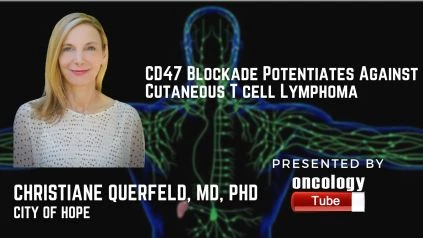Christiane Querfeld, M.D., Ph.D., Director, Cutaneous Lymphoma Program, City of Hope. In this video, she speaks about the AACR 2022 Abstract – 5196 – CD47 Blockade potentiates immunotherapy of durvalumab against cutaneous T cell lymphoma.
Â
View
Â
Immune checkpoint (IC) inhibition for PD1 and PD-Ligand 1 (PD-L1) has shown promising and long-term therapeutic effects in cutaneous T-cell lymphoma (CTCL), but resistance and/or relapses are prevalent. While most research has focused on increasing adaptive immune functions in CTCL, we looked into the role of 1) the “don’t eat me signal” (CD47) and PD-L1 as a dual (innate and adaptive IC)-targeting strategy in CTCL. RNA sequencing and flow cytometric analysis revealed that CTCL tumor cells and CTCL cell lines (MyLa, Hut78, HH, and H9 cells) overexpressed CD47 and PD-L1 when compared to healthy controls, and CD47 was found to be positively linked with PD-L1 in CTCL patients. High MYC expression triggered CD47 and PD-L1 overexpression in CTCL tumor cell lines. Furthermore, flow cytometric analysis revealed that the signal-regulatory protein (SIRP) receptor for CD47 and PD-L1 was considerably more prevalent on macrophages, dendritic cells, and natural killer cells in CTCL patients than in healthy controls. Furthermore, RNA sequencing data revealed that M2 macrophages, immature dendritic cells, and inhibitory receptors expressed natural killer cells were higher in CTCL patients than in healthy controls. TTI-621 (SIRPFc) treatment significantly reduced M2 macrophages, immature dendritic cells, and inhibitory receptors expressed natural killer cells in CTCL patients at the conclusion of treatment compared to baseline. TTI-621 therapy boosted macrophage phagocytic activity in vitro compared to the untreated control. TTI-621 also worked in tandem with an anti-PD-L1 antibody (durvalumab) to convert M2-like TAMs produced by MyLa supernatant to M1-like phenotypes. In vitro, blocking both CD47 and PD-L1 suppressed CTCL cell line proliferation more effectively than either antibody alone or a blank control. Following dual inhibition of in CTCL cell lines, enhanced CD8+ T cell mediated death was found using a chromium-release assay, implying that anti-CD47 and anti-PD-L1 may synergistically accelerate elimination of CTCL tumor cells through unique routes. Cell death-related pathways such as apoptosis, autophagy, and necroptosis were found to be involved in these effects, according to RNA-sequencing studies. Our findings show that CD47 and PD-L1 are key regulators of innate and adaptive immune surveillance in CTCL, and that dual targeting of CD47 and PD-L1 will provide insight into tumor immunotherapy to improve CTCL management.

